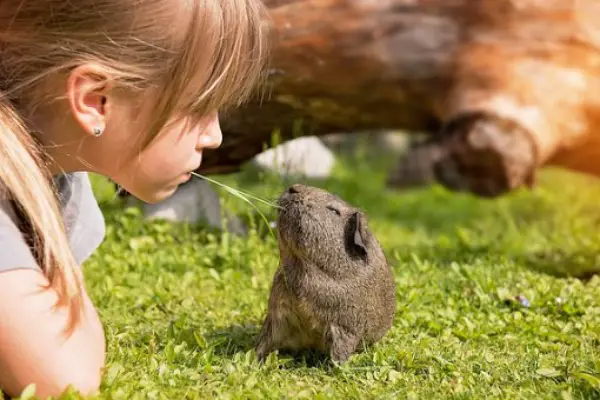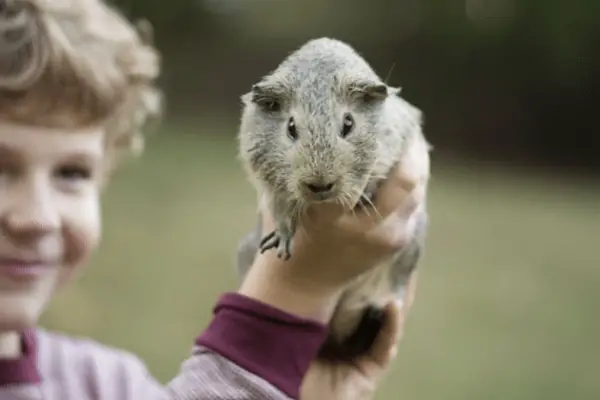13 Hints On How To Comfort a Dying Guinea Pig

How to comfort a dying guinea pig is always a problem for some guinea pig owners and that is exactly what this post is all about.
Guinea pigs are long-living rodents that can live up to 8 years.
This life expectancy exceeds that of many other tiny pets like hamsters, gerbils, mice, or rats, all of which have short lifespans of a few years or less.
We will be discussing how to comfort and care for them in their last days with you.
How To Comfort a Dying Guinea Pig
You should be aware of the following typical methods for comforting and caring for a drying guinea pig:
1. Spend more time with your dying guinea pig
When one of your guinea pigs is dying, you shouldn’t separate the others because they are sociable animals.
The last thing you want to do when your guinea pig makes his triumphant escape is to cause both animals stress and sadness.
If your sick guinea pig is in agony or the other guinea pigs want to roughhouse with him, it could be a good idea to isolate him from his pals.
You must evaluate this circumstance for yourself in order to make an informed decision.
When you notice your guinea pig is approaching his last years, spend more time with him as a way of comforting him.
2. Make feeding easier for your dying guinea pig
A guinea pig that is close to passing away will become exceedingly feeble and unable to eat or drink by himself.
Offer him water from a spoon, syringe, or water bottle to make his passing more bearable.
You may feed your guinea pig a “smoothie” made of hay, water, and ground-up pellets by blending or mixing it.
If your guinea pig doesn’t want to, don’t make him eat or drink.
If he is unable to obtain these items on his own, you should just make them available to him.
To prevent your guinea pig from wasting energy chewing, make sure everything you give him is well-blended.
3. Cuddle with your dying guinea pig
To reassure and show your guinea pig affection, you might gently massage or snuggle him.
This should ease any stress or anxiety your guinea pig may be feeling and let him know that he is not alone.
If you do hold him, make sure it’s in a way you know he enjoys and won’t hurt or annoy him.
The foreheads of many guinea pigs like being softly touched.
Do this while your pet dies if you are aware that he likes it.
Avoid doing anything that may hurt your pet; instead, pay attention to any body language or noises your guinea pig may be making and modify your physical contact with him accordingly.
4. Make your dying guinea pig environment calm
The ideal environment for your guinea pig is a cozy, peaceful setting with neutral lighting that is neither too bright nor too dim.
Your pet could find solace in soft, pleasant, and natural noises.
In order for him to pass away quietly, it could also be advisable to give him some space in the end.
Place a favorite toy or other item near to your guinea pig if you know that it is something he enjoys.
Your cat may feel calmer just by having his favorite things around.
Treat your dying guinea pig like you would a sleeping baby; everything that would be uncomfortable for a pet would also likely be unpleasant for a sleeping newborn.
5. Keep your dying guinea pig hydrated
One of the first signs that your guinea pig is dying is that it isn’t hungry or thirsty. With time, their bodies begin to malfunction.
Hunger and thirst are no longer a part of their existence.
Guinea pigs may become restless from dehydration and may even pass away painfully.
Give your guinea pig foods like watermelon, soft carrots, cucumbers, or apples that are high in moisture.
Make sure the watermelon and cucumber seeds are removed, and peel the apple.
To “nurse” him, lift him up, take the bottle out of the cage, and gently insert it into their mouth.
6. Keep your dying guinea pig cage clean
Whatever its health, a guinea pig’s cage should always be maintained tidy.
It helps to keep their health as stable as possible in doing this.
Cleaning a guinea pig’s cage is crucial during its final days, possibly even more frequently than normal.
This makes sure that your dying guinea pig isn’t exposed to unpleasant odors that might harm its respiratory system.
It also aids in keeping their fur and feet dry.
They will inevitably develop damp fur or feet when they spend the most of the day lying in the same place.
7. Provide soft bedding for your dying guinea pig
The guinea pig will feel really comfortable with soft objects, whether it’s a little blanket, a cushy piece of fleece, or a plush animal.
This is especially true for dying guinea pigs who may have lost use of their legs or who are just in pain.
Even if the paper bedding is comfortable, it’s still beneficial to provide them access to other soft surfaces.
Soft items are a great method to assist them out since they will be lounging about and napping more.
8. Keep temperature under control
Maintain at least a 69°F to 72°F (20°C to 22°C) temperature in the space where they are heated.
If the temperature inside drops below 60 degrees Fahrenheit, your dying guinea pig will be in danger (15 degrees Celsius).
To keep them warm, stuff their cage with basic, unscented ripped toilet paper.
This will keep them warm and provide them with a comfortable bed to sleep in.
Your dying guinea pig will be more at ease and experience less stress if you keep it warm but not too hot.
9. Feed your dying guinea pig little food at a time
It’s not a good idea to let your dying guinea pig eat too much at once.
If your dying guinea pig seems hungry, give it a few minutes to eat.
After then, pause and try feeding it again or giving it more food.
Your dying guinea pig may become worse and feel much worse if you let it feed continuously.
10. Hand-feed or syringe-feed your dying guinea pig
If your dying guinea pig doesn’t appear to be consuming anything from its bowls, you can feed it by hand or with a syringe.
For your dying guinea pig, this can be a better alternative than switching to a new dish. Additionally, it can provide food and fruits.
See whether your dying guinea pig will eat the food crumbs you hold in your hands.
You might choose to carry out this task while seated comfortably so that your dying guinea pig can eat.
To help your dying guinea pig feel confident, stroke and converse with it.
At the mouth’s corner, insert the syringe behind the front teeth.
The plunger should then be depressed. Even better, your dying guinea pig might grab the syringe and feed itself.
11. Talk calmly to your dying guinea pig
A dying guinea pig may feel more at ease if you talk to them in a calm and soft tone.
They frequently hear their owner’s voice, thus simply conversing with them is pleasant.
Many guinea pig owners find it difficult to deal with this because it is difficult enough to watch their pet die.
Although communicating with their pigs might be challenging, doing so ultimately makes any final interactions between them and their owners more meaningful.
Read more: 13 Top Things Guinea Pigs Hate You Should Avoid.
12. Keep your dying guinea pig under wrap
Your guinea pig will stay warm and be more relaxed if you put a tiny, lightweight blanket or piece of soft fabric on top of or around him.
As his biological systems start to break down, your guinea pig can become incontinent.
To keep your pet relatively clean and comfortable, swap out the blanket occasionally.
As they get older and start to die, many animals become considerably more sensitive to cold, therefore keeping your elderly guinea pig’s cage setting a little bit warmer than you used to will greatly enhance his comfort.
To help your guinea pig feel more at ease, choose a material or cloth that he is accustomed to.
13. Provide medication
Contrary to popular belief, giving medication to a dying guinea pig is not ineffective.
A vet will frequently recommend painkillers for a guinea pig that is dying.
This helps them remain at ease as they can for the remainder of their time with you.
It will help them feel much more comfortable if you give them their pain medicine and any other medications they may be taking.
They might need to be handled since they might not take the medication from the pusher syringe.
They should be handled with the utmost care if this is necessary, as instructed.
However, the dying guinea pig will make it simpler to administer the medication.
Accept the grieving of your guinea pig loss
Grieving at the loss of a cherished pet is completely normal.
If you let yourself to feel the normal emotions that come with losing a loved one, you will be able to deal with the death of your guinea pig much more simply.
It actually doesn’t make a difference how you deal with the death of a personal friend or relative.
Ask friends, relatives, or groups of people who are experiencing the same thing for support.
Stay away from those who can’t relate to your loss or who in any way minimize your emotions.
Allow yourself to be depressed and refrain from labeling your emotions as “ridiculous” or “unwarranted.”
Choose a strategy for handling the remnants
Once your guinea pig passes away, you must decide how to dispose of his remains.
As long as it’s hygienic and the remains are kept away from kids and other animals, you can dispose of your pet’s remains anyway you see fit.
Including the corpse disposal of your guinea pig in a memorial or funeral service may ease the mourning process.
Make sure that how you handle your guinea pig’s remains complies with all applicable laws and safety and health standards.
For instance, don’t start a fire where it isn’t allowed or excavate a cemetery on someone else’s land.
How do I know my guinea pig is dead
The telltale signs that your guinea pig is dead include no pulse, no apparent breathing or movement, and loosening sphincters.
A guinea pig in the last stages of life experiences rapid and choppy breathing, and its pulse gradually decreases until it is tired.
Additionally, it’s conceivable that your guinea pig has tremors or has clamped its mouth.
Signs that your guinea pig is dying
Some of the most typical signs of a dying guinea pig include the following:
- Constant weight changes
- A dying guinea pig exhibits obvious behavioral changes.
- In a dying guinea pig, respiratory discomfort appears.
- Weakness and less activity are signs of a dying guinea pig.
- A sharp decline in appetite.
- A slowing down of motion.
- Alterations in urinating and defecating on a regular basis.
- Hair starts to fall out in spots on a dying guinea pig.
- Eye and/or nasal discharge develops in a dying guinea.


![What Can Guinea Pigs Not Eat [14 Unsafe Foods] What Can Guinea Pigs Not Eat](https://petcreeks.com/wp-content/uploads/2022/04/What-Can-Guinea-Pigs-Not-Eat.jpg)
![Can Guinea Pigs Eat Apples [How To Feed] Can Guinea Pigs Eat Apples](https://petcreeks.com/wp-content/uploads/2022/04/Can-Guinea-Pigs-Eat-Apples.jpg)


![Can Guinea Pigs Eat Tangerines [How To Feed] Can Guinea Pigs Eat Tangerines](https://petcreeks.com/wp-content/uploads/2022/04/Can-Guinea-Pigs-Eat-Tangerines-768x614.jpg)